Lindos: The Living City of Homer – II (With pictures by Sir Frederic Leighton, P.R.A.), by Theodore Bent (1891)
[A little-known article, not available elsewhere digitally we believe, by Theodore Bent published in Black & White, 14 March 1891, pp. 173-4. (For some background, see after Bent’s text below.)]
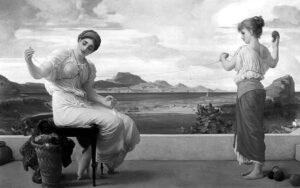
“A walk round Lindos brings one face to face with the ruined architecture of many ages. A short distance from the modern village to the west is a Doric tomb of rare elegance, a large sepulchral chamber hewn in the freestone rock, with a façade showing engaged columns, upon which have been architrave, frieze and cornice, and upon that four marble altars. South of the acropolis are the seats of the ancient theatre cut in the rock, and at the foot of the cliff is another ruined temple, perhaps that of Zeus Polieus, one of the protecting deities of the place.
“It is on the acropolis itself that objects of great interest are found. Here are still to be seen traces, identified by inscriptions, of the far-famed Shrine of Athena Lindia, which stood on the cliff above the sea. Greek legend attributes the foundation of this temple to Danaos and his daughters, and the fame of its sacred relics was great in classical times. Here was kept a brazen cauldron, with a Phœnician legend on it, dedicated to the shrine by Cadmus; here was a model of a female breast in electrum, the offering of Helen on her return from Troy; and here was a copy of the ode, in letters of gold, in which Pindar immortalises the Olympic victory of the Rhodian Diagoras; in short, the reliquary of Athene Lindia was only surpassed by those of Delos or Delphi. Now all that remains of this once favoured shrine, to which merchants from Egypt and Phœnicia sent their offerings, is built into the walls of the fortress which the knights of St. John erected on the cliff.
“Everywhere in Lindos one comes across reminiscences of the knights and their Gothic architecture. The narrow streets, with arched passages over them, are very like those one sees in the capital of the island, and date from the years subsequent to the great earthquake in 1481 which destroyed all the towns in Rhodes, as can be seen from the coats-of-arms and inscriptions thereon. The arched supports were doubtless suggested by the great catastrophe; the palace of the Grand Master, the celebrated street of the knights, all suffered in like manner, and had to be restored, and everywhere the supporting arch was erected, giving a quaint and unique aspect to the streets.
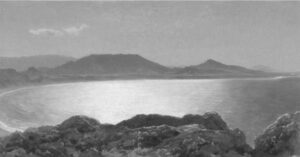
“In Lindos and the town of Rhodes one finds lovely bits of fifteenth century Gothic, far from the legitimate home of this system. Ogival niches and flamboyant arches blend curiously with classic columns; one Christian church has columns from an ancient temple; the tombs of the Grand Masters de Julliac and de Milly are ancient Greek sarcophagi, for the knights were distinctly adaptive. For example, the sculpture of the mausoleum was utilised for the decoration of their castle at Halicarnassus, and the ruins of the temple of Athene served the same purpose at Lindos.
“There are quaint old apartments in the castle containing relics of the knights, and ornamented with landscapes in fresco with Gothic legends; over a chimney piece is sculptured the fleur de lis of France, and on the walls of the room are the arms of the order and of the Grand Master who built the castle.
“‘Our Lady of Lindos’ is the name of the modern Greek church, the lineal descendant of Athene Lindia. It has an elaborately carved screen to shut off the Holy of Holies from the vulgar gaze, and is rich in quaint frescos and much-kissed pictures, showy though tawdry, as every Greek Church is, and on its bell tower is the coat of arms of the Grand Master who built it, proving that the Catholic Knights maintained pleasant relations with their Greek subjects. After the memorable siege and fall of Rhodes in 1522, every Catholic left the island, 4,000 in all, and their convents and churches were converted into mosques for the conquerors. Now in Lindos not a single Catholic is to be found, and comparatively few in the European quarter or Neomarash, just outside the walls of the capital, for no Christian is allowed to reside within.
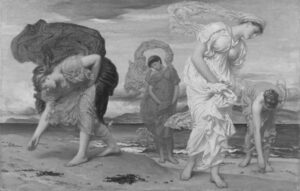
“There are more Turks in Rhodes than in most Greek islands, it being a favourite place of banishment for political exiles, and, of an afternoon, veiled Turkish ladies may be seen walking to and fro near the windmill on the sandy spit busily engaged in picking up black and white pebbles. Every house and courtyard in Rhodes is paved with these, and once the islanders drove a thriving trade by exporting them to Egypt.
“Each veiled lady owns a pile of stones – day by day she adds to it; and from her happy hunting ground she might enjoy, if she were so inclined, lovely views of the lofty mountains of Caria jutting out in finger-like peninsulas into the Ægean Sea not twenty miles away.
J. Theodore Bent.
[Leighton’s pictures, sketches and drawings that featured in the above original article include: – “Street of the Knights” (page 173); “Street in Rhodes” (page 173); “The Acropolis” (page 173; “Marash” [page 173 ]; “Arched Street” (page 174). NB: theses titles are not necessarily Leighton’s own.]A little background to the above article
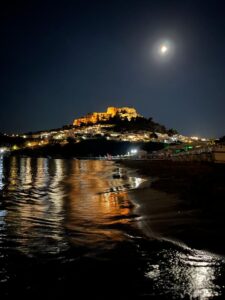
Quickly, before taking his wife Mabel to South Africa to explore the ruins of Great Zimbabwe at the end of January 1891, Theodore Bent seems to have been persuaded by a new popular magazine, Black & White, to write two articles about the Rhodian city of Lindos, really to act as wrap-around texts for some paintings, drawings, and sketches of Lindos and Rhodes by Sir Frederic Leighton (1830-1896), the great English artist of his day and President of the Royal Academy.
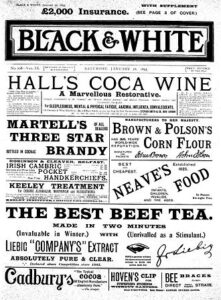 It has to be said, no information has surfaced so far as to whether Bent and Leighton were friends or why such a piece should have been written, other than it was for the earliest issues of a new magazine (Bent’s piece was published over two editions), and the editors wanted to launch it with the work of ‘personalities’; the magazine was pitched as having a focus on illustrations – to compete with names such as The Graphic and The Illustrated London News.
It has to be said, no information has surfaced so far as to whether Bent and Leighton were friends or why such a piece should have been written, other than it was for the earliest issues of a new magazine (Bent’s piece was published over two editions), and the editors wanted to launch it with the work of ‘personalities’; the magazine was pitched as having a focus on illustrations – to compete with names such as The Graphic and The Illustrated London News.
Sadly, the quality of Leighton’s published paintings in reproduction is poor in these two original Bent pieces and they do not appear here (their titles are listed below Bent’s texts for those interesting in finding them). Replacing them are freely available versions of the popular artist’s works relating to Lindos and Rhodes, and very lovely they are.
Leighton was 37 when called in to Rhodes during a tour of the Levant in 1867. His memories of his stay in Lindos and the area of Neochori (Rhodes Town – non-Turks then could not stay within the walls of the Old Town) stayed fresh with him for the rest of his life, and he used remembered scenes as backdrops in many of his most popular works. Indications of his feelings for Rhodes appear in (1) his letters home and, (2) his diary:
1) Royal Steamer, Adriatic, 28 Nov [1867]: “My Dear Papa… I told you, I believe, in my last how much I had enjoyed and, as I hope, profited by my stay in Rhodes and Lindos… The weather, which was very beautiful at the beginning – indeed during the greater part of my stay in the Island – was not faithful to me to the end; it broke up a few days before my departure, and, to my very great regret, prevented my painting certain studies which I was very anxious to take home: on the other hand, I had opportunities of studying effects of a different nature, so that I can hardly call myself much the loser as far as my work in Rhodes was concerned.”
2) About a year later, on a subsequent trip to Egypt he writes in his diary how a sprig of basil sets him off reminiscing: “As I smell it I am assailed by pleasant memories of Lindos – ‘Lindos the beautiful’ – and Rhodes, and that marvellous blue coast across the seas, that looks as if it could enclose nothing behind its crested rocks but the Gardens of the Hesperides; and I remember those gentle, courteous Greeks of the island… and the little nosegay, a red carnation and a fragrant sprig of basil, with which they always dismiss a guest…”
As for Bent’s text – it’s hack work, cobbled together in an obvious hurry, although his easy, affable style comes through – the same style that was to make his books on Greece (1885), Zimbabwe (1892, and Ethiopia (1893) so popular.
In actual fact, there is a little conceit going on, for although Theodore and Mabel did visit Rhodes in 1885, it was only for a matter of a few days and they never sailed down to Lindos, nor made the lengthy journey there on equids. There are no references in Mabel’s diary to going further than Filerimos, and Theodore would most certainly have written of any Lindian visit in the late 1980s among his many articles on the Eastern Mediterranean. He did publish a review of their days in Rhodes town in 1885, and one or two references in it echo in his two efforts for Black & White. Other echoes sound too – from the pages of such actual visitors (their works surely known to Bent) as Tozer and Newton, and armchair scholars such as Cecil Torr. Bent, in the interests of his own art, was not averse to making things up if needs must…
Click here for Bent’s earlier article the previous month, viz “Lindos: The Living City of Homer – I”. Black & White, 28 February 1891, pp. 109-10.
Click here for Bent in Black & White, an Introduction.
 Leave a comment or contact us about this article
Leave a comment or contact us about this article
